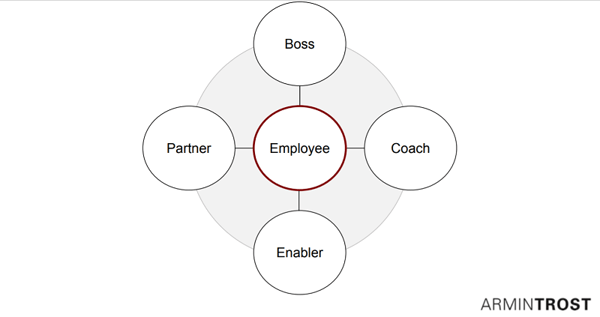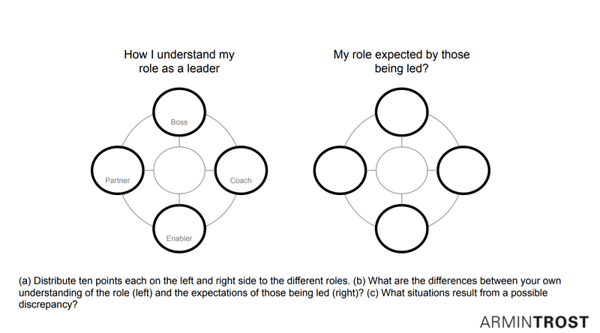How HR plays a role in leadership development

Leadership development is one of the most important areas of HR management. We spoke with HR Leader Prof. Dr. Armin Trost, who shares advice on how to set your company on the right track.
For some time now, developments in the labour market have been challenging companies to clearly position themselves as employers, brushing up their image to attract suitable candidates and retain and motivate qualified employees in the long term. Managers, and the way they lead within the organisation, are a crucial part of this.
We’ve witnessed a significant shift in leadership behaviour, in a move from an authoritarian to a cooperative leadership style. This includes a change of standpoint, from one of punishment and bossing people around, so to speak, to one of engagement, self-responsibility and reward. We tackled this issue in our latest webinar on HR’s role in leadership - Enable your managers to become true leaders and mentors with Prof. Dr. Armin Trost. Armin is not only a famous bestselling author, with his latest book being Human Resources Strategies: Balancing Stability and Agility in Times of Digitization, but he’s also a renowned and prominent thought leader in human resources management.
Did you miss the webinar? No problem, you can watch the recording here:
Strategic HR leadership roles
Companies often think it’s a great idea to implement standard theoretical leadership models, but they are seldomly put into practice. This is because most leadership models focus on leaders attributes: how you should be and how you should behave.
“Most leadership models either focus on a leader’s attributes or a leader’s behaviour.”
- Armin Trost -
Armin highlights that this is far from ideal. He likes to focus on the context, relationships and roles of teammates. After all, leadership is about the relationship between the leader and the ones who are being led.
We know only too well that many companies struggle with their understanding of leadership if they have any at all. They think having smart career-driven leaders is enough: leaders who can steer their companies to success with management by objectives, reports, KPIs, controlling what everyone’s doing, etc.
Indeed, in the past, this was the way things were, and many companies adopted this approach and assumed things would never change.
Well, guess what, things have changed. New generations of employees are joining the workforce; new ways of working are emerging, such as remote work and we need to adapt to new ways of both working and thinking too.
The role of HR in uncertain times
Some might say that you need a strong leader during a crisis, but how realistic is that? It’s easy to follow a strong leader who knows everything, but wouldn’t it also make us feel like children - constantly asking for approval and guidance? And wouldn’t the fact that our opinion doesn’t count anymore dampen our motivation? You get the message; it’s hard to follow and even harder to lead.
That’s why flexibility and adaptation are key. In most organisations, some people work on tasks with high certainty in outcomes, others on projects with unclear outcomes while also following a plan. Constant adaptation seems to be the way to go in times of uncertainty, such as the Corona pandemic we’re facing now.
“We have to learn as we go along
- Armin Trost -
As a result, HR managers should adapt their company’s way of working by highlighting that, while managers may have additional knowledge and some rudimentary expertise, its the employees themselves who are the real experts.
Think about shared leadership: the way teams are successful WITHOUT having a leader, but BECAUSE they don’t have one. They lead themselves: different people take the lead at different times, and they work towards a common goal.
Be aware of the leadership context
Contingency leadership says there is no right method of leadership, just the correct behaviour in the right situation. And what works in one situation may not work in another.
You need an effective strategy, of course, to ensure everyone is on the same page and working towards established goals. Translating the strategy into a vision of what needs to be achieved is just as important. This will ensure that employees go out of their way to deliver excellence, going the extra mile to achieve goals together - for the company, for the project, for the bigger picture.
“Your vision is the emotional, intuitive, and accessible strategy that employees should instantly understand.”
- Armin Trost -
Remember the last time you completely lost track of time, while engrossed in your favourite hobby? When you couldn’t care less about eating, sleeping or resting because you were so immersed in your project?
This flow is exactly what we mean! Discover this sense of purpose and fulfilment in your employees, the ones who lose themselves in their work, and you’ll have found the right work attitude.

Be clear of your leadership mix
We have to differentiate between several different leadership roles. A boss will always love taking the command, possibly micro-managing, wanting to be involved in the fine details and make all the decisions.
On the other hand, a coach responds to their employee’s questions and will also ask questions. As a coach, he doesn’t give answers but coaches the employee to work independently.
As a partner, you work together as a team, sharing responsibilities and focussing on the team as a facilitator.
Some leaders take the enabler or mentor role, asking themselves what they need to do to help employees make their own decisions and do a good job.
So now it’s up to you, which role will benefit your company most?
Incidentally, most leaders are a mix of all four types. They often see themselves as one type, while in reality, their team might think the exact opposite. This discrepancy can cause a lot of friction in a team.
Make sure you and your team have the same understanding of the leadership mix
So, establishing clear guidelines about understanding and communicating these roles should be vital for all HR managers.
We have to remember that usually, bosses also have bosses to answer to, which can create another form of ambiguity. Needing to be different things in different contexts can be challenging. Leaders need a clear vision and shared understanding of when and how to address certain issues at any given time.
Leaders should take into consideration that many employees like real bosses: the ones who aren’t afraid of making uncomfortable decisions, who take responsibility and offer guidance. For these employees, the “coach” leader could be a disaster as no-one would be happy. It’s therefore vital that HR managers and leaders find the right candidates for each team, to bring out the best in people.
Our HR leadership skills tip: Find out what your employees expect from you and follow through!
How can you turn bosses into coaches?
Armin recommends that we do this in a group exercise. To do this, business and HR leaders come together in a group and ask the following questions:
- What are the business challenges my organisation is facing?
- What’s the context in which I am leading?
- Do you need to optimise your leadership mix?
- What may be the best role mix to be effective?
- How am I supposed to deal with real situations?
- How do I need to adapt my leadership behaviour?

As a warm-up, Armin prepares a template where he asks managers to consider ten points. They then allocate them across different roles, and ask themselves what proportion they think they need, or is expected, to carry out their roles successfully. This is also a great way to spot potential conflicts or challenges further down the road.
The second step involves running through real and critical leadership situations and working through them. Discuss how you would act when faced with common and recurring conflicts so that you can prepare for them. This is because leaders often fall back into their old role of being a boss in stressful situations, so this kind of preparation can help prevent that.
HR and leadership development
Providing the right framework is a key aspect in HR. You should run workshops, training and leadership coaching sessions so that people have time to reflect on the context, their roles and relationships actively.
HR should also offer supportive tools and processes such as employee surveys or feedback tools, so that managers can see the expectations of their team and act accordingly.
As a rule, HR managers should see themselves as a coach, rather than a commander and leader who gives the orders. They should coach, and not judge or lead.
If this sounds like drivel to you, then think about all the money you spend finding, hiring and onboarding new employees. And then think about how they might lose interest in their job and start to look for a new one, in a company where they feel more valued and involved.
Working and leading your way as a coach helps you avoid judging your employees formally. Give them feedback instead, and encourage them to ask for it too. Create a workplace that people want to be a part of.
Role of HR in leadership
Motivation, understanding, empathy and personal responsibility are key prerequisites for people management and leadership today. HR management of the future will be less concerned with overarching processes, responsibilities and KPIs as a result.
Instead, they will enable managers to become true leaders who think, communicate, collaborate, and act for the long term, to grow personally and professionally.
That way, your employees will stick around for a long while yet.


